Brave New (Gender) World

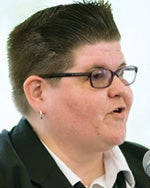
By Melanie Coon
The doors of the University of Rhode Island Gender and Sexuality Center open into a cool vestibule lined on one wall with stone. The choice of material was intentional. “That’s our nod to Stonewall,” says Center Director Annie Russell, referring to the famous gay bar in New York’s Greenwich Village—now a national monument—where a police raid in June 1969 sparked neighborhood protests that formally launched the gay rights movement in America. The Center, which opened in May 2015, is a combination retreat, gathering space, counseling mecca, and living classroom for the entire University community. It is also a symbol for just how far the University has come.
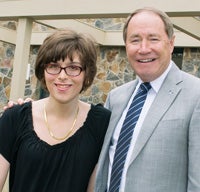
One Story. Many Lives.
When Jessica Brand ’14 was wheeled into an operating room for major surgery last year, she wasn’t nervous.
“I was calm and happy,” she reflected soon afterward. “I’d been waiting for this all my life.”
Brand knew there was a problem with her body as far back as she can remember. She and other toddlers were telling secrets at daycare. One boy whispered that he didn’t have a belly button. Brand spoke up: “I’m a girl.”
But Brand had been born a boy. By age 4, she wanted Barbie dolls for Christmas. She hung around girls playing house—or at least tried. “They always kicked me out,” she says. In grade school, women TV characters tugged at her heart. Sabrina, the teenage witch, was her idol.
She kept her feelings inside, coping by studying obsessively. “I learned my sorrows away,” she says. “I couldn’t be myself. Living in the wrong body made me feel like an outsider, and it made me feel strange.”
She withdrew in middle school—and then she hit puberty in ninth grade, and her world fell apart. Depressed, she rarely left her bedroom. She wouldn’t allow anyone to take her photo. She tried to kill herself.
“I wasn’t developing right,” she says. “I needed to look and develop like the other girls, which was the opposite of what was happening to me. I was getting male characteristics, and that was frightening.”
Finally, she couldn’t hold it in any longer. She remembers the exact day: Jan. 24, 2009. She was 16. Sitting in a restaurant parking lot with her mother, Brand asked if her love was unconditional.
“Yes,” replied her mother, Susan Trostle Brand, of Exeter, a longtime education professor at URI. (Jessica Brand’s father, Stephen Brand, was also a URI education professor and supportive of his eldest daughter; he died unexpectedly three years ago.)
Hormone treatments followed, and in 2013, she changed her name. She would be Jessica, Jess for short. At URI, where she was a double major in finance and French, she felt safe and accepted, and found the courage to start reaching out to other students, hoping to help them find peace. She spoke in her mother’s social equity class. She gave a talk to students during URI’s Diversity Week. And she spoke at the 2015 opening of the University of Rhode Island’s Gender and Sexuality Center:
“Just be, and be yourself,” she told the crowd. “No matter your body, your background, your sexual orientation, your gender identity, or, as in my case, your voice. The rest will fall into place.”
Just a few days later, she flew out to California for her gender confirmation surgery, with much of the cost covered by her student health insurance. She was the first URI student to use the coverage.
A documentary, What I’m Made Of, featuring Brand and others, is expected to air next year. wimodoc.com
As recently as six years ago, prospective students Googling URI got a very different impression: it was on Princeton Review’s top 20 LGBTQ “unfriendly” list. That September, LGBTQ students staged an eight-day sit-in at the library. Brian Stack ’12 was one of the organizers. He recalls his frustration at attending multiple diversity retreats—after which progress seemed to be made, but not on LGBTQ issues. “Issues like harassment in the dorms were not being addressed,” he recalls.
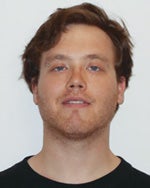
During the URI sit-in, 150 miles away, Rutgers University freshman Tyler Clementi committed suicide after his roommates circulated video of him engaging in sexual activity with another male student. Suddenly there was a national debate on bullying and the treatment of gay, lesbian, bisexual, and transgender students at colleges and high schools. Response on campus here was huge. More than 1,400 students signed the protestors’ petition. President David M. Dooley said at the time that the protest “was good for the campus. It helped us all understand what these students are facing and what we need to do to make the campus more supportive and welcoming. It is our responsibility to make sure that every student feels safe and can enjoy an atmosphere that encourages learning and development.”
Higher education is hardly known for its agility or capacity to pivot. Yet, in the fall of 2014—just four years after the Library sit-in—Campus Pride, a national nonprofit organization, gave URI a five-star rating and named it one of the top 50 LGBTQ-friendly universities in the country. In the equivalent of a University nanosecond, URI underwent a transformation. Today, more than 15 national institutions and one international institution use URI as a model for their own LGBTQ programs and services.
For Stack, now pursuing a Ph.D. in the history of sexuality at Washington State University, the fact that people “came together and addressed these issues with gravitas” gives him hope. His dream would be for URI to develop a queer studies program, lending credibility to queer academia. “I don’t think President Dooley ever imagined that part of his legacy at URI would be turning around the climate. I give him a lot of credit for taking us seriously and taking action.”
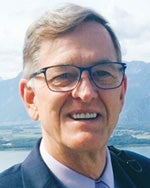
But the story has been decades in the making, and progress hasn’t always been in a straight line. When Gary Burkholder arrived on campus (Burkholder earned degrees at URI in 1992, 1995 and 2000, and was a recipient of a 2014 Distinguished Achievement Award) he had newly come out and was eager to collaborate with other students around issues of diversity and acceptance. “The Gay Lesbian Bisexual Association (GLBA)—that was what we called it at the time—went through a number of iterations and degrees of strength,” he recalls. “Often when someone in a leadership position graduated, the organization would dissipate.”
A mobilizing moment came in the spring of 1993, when Burkholder and others successfully united to lobby the undergraduate senate for funds to attend the historic April 25th March on Washington for Lesbian, Gay, and Bi Equal Rights and Liberation. A year later, he took part in a State House demonstration organized by the Rhode Island Network of Gay Students that brought together students from different schools to fight for civil rights. “It was such an exciting time,” says Burkholder, now editor-in-chief of Higher Learning Research Communications and a senior executive at Laureate Education, Inc. “And honestly, we did not run into many roadblocks. It felt like we had support for what we were trying to do.”
But URI was also part of a national backlash against gay rights. Strongly worded letters and articles protesting the visibility of the gay rights movement, which are featured in a retrospective exhibit at the Center, hint toward why, in the late 90s, GLBA went underground. URI was not alone in this regard. In fact, a number of studies conducted in the late 1990s and early 2000s by Penn State Professor Susan Rankin, a leader in the field of assessing the institutional climate for under-served communities, showed that at colleges and universities nationwide, students “considered leaving their schools because of the climate. They didn’t feel safe or welcome.”
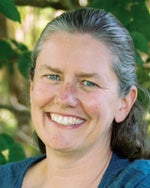
Holly Nichols ’98, who has been a member of the URI community for nearly two decades, is a firsthand witness to the dramatic changes from the 90s to today. A clinical counselor in the University’s counseling center, Nichols’ most cherished role is as facilitator of the LBTQ women’s group she co-founded in 2010. “It’s a place for women to give and receive support around issues of identity and other life stressors, while also having fun,” she says. “We laugh, color, or decorate cookies, all while making time to listen deeply to one another, and offer comfort and encouragement.” It was the students in this group who produced the 2011 film It Gets Better at URI: Coming out for Change, part of the national “It Gets Better” effort founded by gay activist and writer Dan Savage after Tyler Clementi’s suicide.
“It does get better,” says Nichols, noting that the 41-minute film has been shown to more than 2,000 people and is required viewing for URI athletes, coaches, and staff members in athletics. More than 80 members of the URI community—LGBTQ people and their allies—participated in making the film. There is a moment in the film when Nichols shares her own experience. She recalls picking up a copy of GLBA newsletter The Three Dollar Bill in the 1990s, and feeling like she was finally part of a community. “Then I think about this project, and working with all the students on this, and the connection between those two. I am hoping this is someone’s Three Dollar Bill.”
When Russell arrived in January 2012, she found that despite the progress, mistrust between administrators and students persisted. “The campus was hurting. My first two years, there were some low lows. It took a tremendous amount of hard work to reconcile differences and build trust. But there were also some high highs, and obviously, breaking ground on the Center was one of those.”
Russell recognizes the importance of the University’s past even as she is laser focused on URI’s potential for even greater change. Under her leadership, the Center has reinvigorated the campus community with more than 100 new programs, services and events.
Nichols believes the Center is especially valuable for the emerging trans community. “In my role as a counselor, I see more people willing to be out as trans—that is a wonderful shift. The Center has created more programming for trans people, inviting trans speakers and offering training on trans-specific issues. Culturally we have come so far as an institution. More often than not students are happily surprised at the reaction when they come out.”
Nichols would like to see the Center’s planned “Visibility Project” take off so that students can quickly identify supportive faculty and staff.
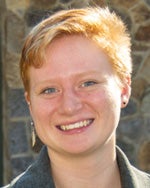
Mara Migdalski ’16, who worked at the Center as a student specialist in health and research of LGBTQ and identities, says the climate has been set at the top: “President Dooley is openly supportive. He comes to our events and is photographed. That is just such a sign of campus solidarity. He addresses issues immediately and ensures that we are safe.”
The Center played a catalytic role when, on June 12, 2016, the nation was shaken by the tragic shooting deaths at an Orlando club. A 29-year-old security guard killed 49 people and wounded 53 others at a gay nightclub, the deadliest mass shooting by a single shooter in United States history and the deadliest incident of violence against LGBTQ people. Shaken, the campus came together for a peace vigil on the Quad.
Migdalski’s reflections just before the Orlando tragedy seem prescient. As she was preparing to leave the place she had described as the cornerstone of her URI experience, Migdalski noted, “The Center is the most welcoming place on campus today for LGBTQ students. And its roots of welcome are spreading. We’ve come so far—but the work is never done.” •
Changing Mores. Changing Words.
Grammarians, hold on to your hats. “They” is no longer accepted only as a plural pronoun. The American Dialect Society, a 127-year-old organi-zation of linguists, lexicographers, etymologists, grammarians, historians, researchers, writers, editors, students, and independent scholars, voted for “they” used as a gender-neutral singular pronoun as the Word of the Year for 2015. “They” was recognized by the society for its emerging use as a pronoun to refer to a person who consciously rejects the traditional gender binary of he and she—in other words, someone who may identify as “non-binary” in gender terms. In 2015, singular “they” was also endorsed by the Washington Post style guide.
It will probably not come as a surprise that the resources section of the Gender and Sexuality Center features not one, not two, but four glossaries of terms. Russell explains: “Language matters in the history of the queer movement. When people claim and name who and what they are, they are no longer marginalized.” Here is a sampling of our brave new vocabulary:
Transgender: Umbrella term for any gender identity that differs from the one associated with the sex assigned at birth.
Genderqueer: A gender identity that falls outside of the male/female binary. A third gender.
Pangender: Having a fluid identity. Might be expressed as both male and female, or shift from one gender to the other. Under the umbrella term genderqueer.
Cisgender: Possessing the gender identity commonly associated with one’s biological sex. “Cis-” is a Latin prefix meaning “on the same side as.”
Heterosexism: The belief that all people are heterosexual, the assumption and/or belief that heterosexual relationships and behavior are superior, and the actions based on this assumption.
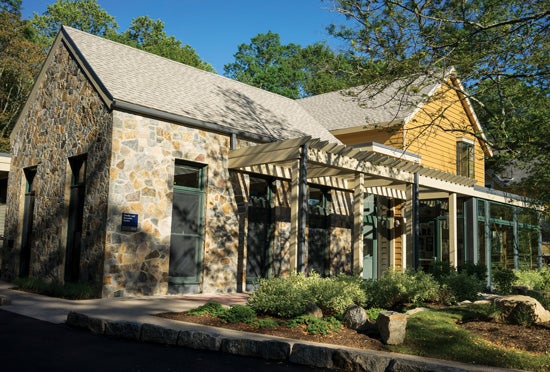
A Center for Everyone
The Gender and Sexuality Center features programming year round, punctuated by three events: Trans Awareness Week, the Symposium, and Coming Out Week. Additionally, URI’s Safe Zone Program, run through the Center, has been a phenomenal success, with more than 2,000 participants to date. Through Safe Zone, the Center provides two-hour workshops on basic issues affecting the LGBTQ community and how to be an ally. The program is designed to increase awareness, knowledge, and support of people and issues; build a visible support network on campus; and improve the campus climate. “Allies help transform the culture,” says Russell. “And learning to be an ally is about the other person,” she adds. “You are not the hope for all queer people.”
Faculty Pioneers
Students have not been the only drivers of awareness and solidarity at URI. On October 18, 1994, Professors Mary Cappello and Jean Walton (now, respectively, in the English Department and the Harrington School of Communication and Media) put out a call for papers for the first annual interdisciplinary symposium “in the area of Lesbian, Gay, Bisexual Studies.” As leaders of the Committee to Eliminate Heterosexism and Homophobia on Campus, Cappello and Walton were URI faculty-pioneers. The inaugural symposium, “Setting Out,” was held in 1995. Cappello and Walton’s original memo to fellow committee members is displayed as part of a retrospective exhibit at the Gender and Sexuality Center, along with materials from student protests.
Photos: Nora Lewis; Gary Glion
 Home
Home Browse
Browse Close
Close Events
Events Maps
Maps Email
Email Brightspace
Brightspace eCampus
eCampus


